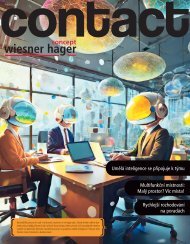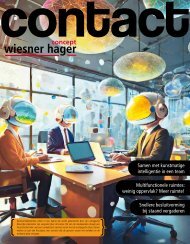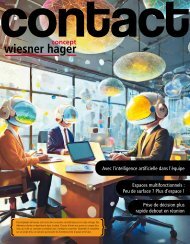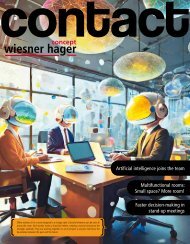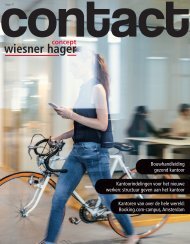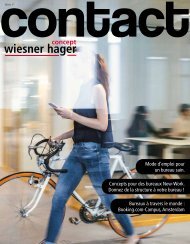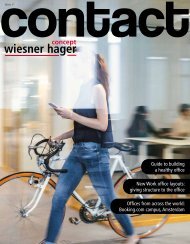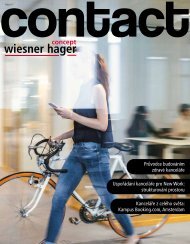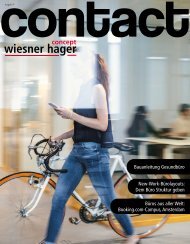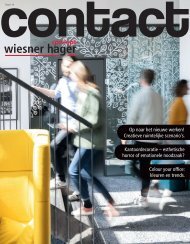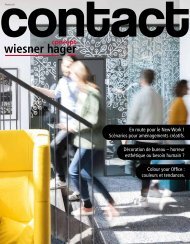contact_magazine_#35_EN
The days of only providing the basics, in traditional multipurpose rooms, completely lacking in atmosphere and character, are over! The conference rooms of the future will have to be warm, plush and really cosy. This means that, to succeed in today’s event industry, you need to be inspired! Our cover story looks behind the scenes at these new “settings for synergy”.
The days of only providing the basics, in traditional multipurpose rooms, completely lacking in atmosphere and character, are over! The conference rooms of the future will have to be warm, plush and really cosy. This means that, to succeed in today’s event industry, you need to be inspired! Our cover story looks behind the scenes at these new “settings for synergy”.
You also want an ePaper? Increase the reach of your titles
YUMPU automatically turns print PDFs into web optimized ePapers that Google loves.
Edition 35<br />
The architecture of hospitality:<br />
Setting the stage for synergy.<br />
AKoS Collaboration Center.<br />
Office culture put to the test.<br />
Hotels from around the<br />
world: NoMad London.
Conferences with<br />
a living-room feel.<br />
The days of only providing the basics, in traditional multipurpose rooms,<br />
completely lacking in atmosphere and character, are over! The conference<br />
rooms of the future will have to be warm, plush and really cosy. This means<br />
that, to succeed in today’s event industry, you need to be inspired! Our<br />
cover story looks behind the scenes at these new “settings for synergy”.<br />
Next come some useful ideas for travellers. Equipped with those, off we go<br />
to an unusual business centre. We learn about a smart idea for co-working<br />
which offers an alternative to working at home and rekindles team spirit.<br />
Then we go with Anna and Nils Schnell on a whirlwind tour of 34 countries<br />
and four continents and visit more than 130 companies. The couple<br />
have looked into modern ways of working, the world over. They share their<br />
findings and experiences with us in a fascinating interview.<br />
If you’re going to travel very far, you’ll need a hotel: and we didn’t just<br />
check in with the NH Group, the third largest provider in the business<br />
hotel sector – we fitted out the hotels with some of our bestsellers.<br />
We also have a few useful tips for dealing with some of the old contentious<br />
issues regarding office culture. And then we take a critical look at jogging<br />
bottoms, the new laid-back approach to the office dress code and wearing a<br />
collar and tie: is it really becoming a pain in the neck for some people?<br />
Last but not least, we let Generation Z have a word – after all, they are our<br />
future!<br />
So now, pack a little spare time in your bag and come with us on a journey<br />
through these exciting times.<br />
Laura and Markus Wiesner
The architecture of hospitality ............................... 04<br />
Trend Watching: Useful ideas for travellers ........... 07<br />
Interview: Horst Heinzmann .................................. 08<br />
Anna and Nils Schnell on Modern Work Tour .......... 10<br />
Reference story: NH Hotel Group .......................... 12<br />
Office culture put to the test ................................. 14<br />
Dress code for the office ....................................... 16<br />
IT solutions for shared desks ................................. 18<br />
Hotels from around the world: NoMad London ..... 20<br />
What’s on your desk, Michaela Wolf? ................... 23<br />
Generation Z: All change in the world of work ...... 24<br />
Showroom ............................................................. 26<br />
Publisher: Wiesner-Hager Möbel GmbH, Linzer Strasse 22, A-4950 Altheim, T +43/(0)7723/460-0, altheim@wiesner-hager.com, www.wiesner-hager.com, thinknewwork.com;<br />
concept/editor: Wiesner-Hager, mintmind Communication GmbH; layout: mintmind Communication GmbH; guest author: Wojciech Czaja;<br />
no liability accepted for typesetting and printing errors; 11/2022.<br />
<strong>contact</strong> 3
Hospitality Concepts<br />
Setting the<br />
stage for<br />
synergy.<br />
Hotels play an important role in providing the<br />
market with meeting and conference facilities.<br />
However, thanks to COVID and the ever-increasing<br />
digitalisation of business communications,<br />
the situation has changed dramatically. Here we<br />
take an encouraging, inspiring look at the conference<br />
rooms of the future.<br />
It’s like sitting in a factory loft through which a quick<br />
blast of Modern Talking and Miami Vice has just<br />
blown for a few seconds. On the one hand, big factory<br />
windows, exposed Spiro ventilation ducts and a<br />
rather rough ceiling made of grey insulated boards.<br />
On the other, dark, concrete-grey walls<br />
and a grey and purple checked carpet<br />
in a chessboard design that looks a<br />
bit like an unfortunate post-modern,<br />
chromatic aberration. All that’s missing<br />
are the clouds of smoke from which<br />
Thomas Anders and Don Johnson will<br />
suddenly emerge. “The days of only<br />
providing the basics, in traditional multipurpose<br />
rooms, completely lacking<br />
in atmosphere and character, are over”,<br />
says Erich Bernard, Managing Partner<br />
at Vienna-based architects BWM.<br />
“Before COVID, when the conference<br />
hospitality sector was still riding high<br />
and demand exceeded what the market<br />
could supply, there wasn’t really any competition.<br />
But in a very short time, COVID has turned a<br />
supplier’s market into a buyer’s market. To succeed<br />
in today’s event industry, you need to be inspired!”<br />
A few months ago, BWM finished the new Hotel<br />
Gilbert in the Breite Gasse, just a stone’s throw from<br />
Vienna’s museums district, and in September there<br />
was an Open House event to show off the refurbishment<br />
project. The hotel, a crossover between “urban<br />
stay” and “industrial luxury”, has 56 rooms and, at<br />
its heart, a glass-roofed, light-filled lobby with a bar,<br />
restaurant and cosy chill-out lounge, complete with<br />
fireplace and retro tiles. Adjacent to it, slightly raised<br />
up on the first floor, with huge windows and a gallery<br />
running round one side, are two conference rooms<br />
for twelve and 30 people, respectively.<br />
Even more dramatic, even more enticing, is the<br />
Marriott that BWM built on the Potsdamer Platz in<br />
Berlin (2018). Lit up in neon lights behind a thin<br />
curtain in the main conference hall are poetic words<br />
associated with meetings: connect, inspire, imagine,<br />
celebrate. In the pre-function and break-out rooms,<br />
4 <strong>contact</strong>
on the other hand, BWM created an Art Deco feel,<br />
with dark wood veneers, highly polished floors,<br />
plush velvet upholstery, golden-coloured furniture<br />
and geometric designs on the walls, reminiscent<br />
of the Chrysler Building, the Great Gatsby and<br />
the Roaring Twenties in New York. “It needs to be<br />
warm, plush and really cosy”, says Bernard. “Clients<br />
and conference attendees long for colour and textiles,<br />
for comfortable, laid-back, low seating – and for<br />
multifunctionality that works perfectly, but is hidden<br />
behind the appearance of a lovely, homely living<br />
room.” And unlike in<br />
earlier years, says the<br />
architect, the break-out<br />
and pre-function rooms<br />
are also becoming more<br />
and more important.<br />
“No, this isn’t wishful<br />
thinking or a construct<br />
of architectural<br />
theory – it’s the reality.<br />
I haven’t attended a<br />
single conference since<br />
COVID that left me<br />
cold in terms of the BWM Hotel Gilbert, Gallery<br />
space it took place in.<br />
Most of the events were held in pretty sensational<br />
locations, often with fantastic views of the city or the<br />
scenery. There’s tremendous competition now. In the<br />
age of Zoom and online conferences, only the best<br />
will survive.” This is confirmed by Susanne Baumann-<br />
Söllner, Vice-President for Congress Management at<br />
the Internationales Amtssitz- und Konferenzzentrum<br />
Vienna (IAKW – International HQ and Conference<br />
Centre) and also spokeswoman for the Board of<br />
the ACV Austria Center Vienna, by far the biggest<br />
conference centre in Austria. “Architecture – and<br />
the specific spatial and technical experience that it<br />
provides – is becoming more and more important,<br />
because the role of conferences is not just to share<br />
knowledge but also to enable people to network and<br />
enjoy sensory experiences that are outside their normal<br />
everyday working lives. In the wake of COVID<br />
and the unstoppable march of online communication,<br />
the value of meeting together in person has<br />
become even greater.”<br />
And for Christiane Unawatuna Hewage, Director<br />
of MICE at Verkehrsbüro Hospitality, the technical<br />
equipment and the rooms and online services that<br />
are available are<br />
all-important: “In<br />
the past, conference<br />
rooms in the hospitality<br />
sector were<br />
generally booked up a<br />
year in advance. Now,<br />
though, bookings<br />
can come rolling<br />
in just two or three<br />
months before the<br />
event. This means<br />
that the cancellation<br />
terms have changed,<br />
and of course hotels<br />
nowadays need to be able to react very spontaneously<br />
to last-minute alterations.”<br />
Will the event actually happen? Is it a purely analogue<br />
event or a hybrid one? How well-prepared are<br />
you to respond to any new government regulations,<br />
for example on hygiene, social distancing or providing<br />
refreshments? And what can you do if the<br />
conference is going to take place entirely online? At<br />
the Austria Trend Hotel Savoy near the Botanical<br />
Gardens and the Belvedere, during the pandemic in<br />
2020 they sacrificed one traditional suite and turned<br />
it into a streaming suite – with a sound-insulated<br />
© BWM Architekten Michael Königshofer<br />
It needs to be warm,<br />
plush and really cosy.<br />
<strong>contact</strong> 5
Hospitality Concepts<br />
media room, a control room, two lecture rooms<br />
and even a dressing room for the speakers. Another<br />
important aspect is the question of environmental<br />
sustainability, which affects the conference sector as<br />
much as everyone else. “In my experience, many big<br />
companies will only organise their conferences and<br />
symposia in venues where they can say it is a certified<br />
Green Meeting”, says Michaela Reitterer, owner<br />
of the Hotel Stadthalle and, until the start of this<br />
year, long-term President of the Austrian Hoteliers<br />
Association (ÖHV). “I would<br />
advise all hotels and hoteliers<br />
to invest accordingly, if they<br />
want to remain successful<br />
in the market.” The German<br />
hotel expert Maria Pütz-Willems,<br />
publisher of the industry<br />
newsletter Hospitality Inside,<br />
makes this point even more<br />
strongly: “The semi-professional<br />
family hotel that just has<br />
one meeting room somewhere,<br />
equipped with whatever Marriott Hotel, Ballroom<br />
comes to hand, has had its<br />
day. Because big, listed companies that have made a<br />
commitment to their shareholders and stakeholders<br />
that they will meet certain environmental governance<br />
standards, and have to prove regularly that they<br />
are acting sustainably, simply can’t even approach a<br />
hotel anymore which doesn’t have green certification.<br />
The hotel industry would be well advised to adapt<br />
its conference facilities as quickly as it can.” The key<br />
aspects of green certification include being accessible<br />
on public transport, providing a suitable transport<br />
option for the final mile, reducing packaging on<br />
food, goodies and give-aways, using as little plastic<br />
as possible, running on green energy and generally<br />
being resource-efficient in energy consumption, sourcing<br />
food that is local and seasonal and if possible<br />
even has a social benefit, using eco-friendly cleaning<br />
materials and ensuring that the hotel’s overall CO 2<br />
footprint is low and transparent to all. “And what I’m<br />
seeing in the market,” says Pütz-Willems“, is that it’s not<br />
just the big players with 4- and 5-star hotels in the<br />
cities who have invested in this. Many medium-sized<br />
family-run companies have already done so as well,<br />
such as Lindner Hotels and even budget chains like<br />
Ruby Hotels. And classic holiday parks like Center<br />
Parcs and Club Med are also increasingly understanding<br />
the relevance of conferences and online working.<br />
It’s no wonder, because the WiFi on the back<br />
of an elephant somewhere in the jungle in Thailand<br />
is probably more stable than it is here in Germany.”<br />
Especially in the budget sector,<br />
more and more interesting<br />
hospitality products and business<br />
services keep popping up.<br />
For example, the budget chain<br />
Ruby Hotels has created a sister<br />
company, Rubyworks. This offers<br />
separate co-working spaces<br />
and conference facilities for<br />
hire that can be made available<br />
to both non-residents and hotel<br />
guests. Pütz-Willems: “The Rubyworks<br />
locations are usually<br />
only a few minutes’ walk from<br />
a Ruby Hotel. The service has gone down very well<br />
and I think it’s a smart and intelligent reaction to the<br />
trend over the last two years.” The market has become<br />
very difficult and during the lockdowns it seemed<br />
to be on its knees, but the conference business is not<br />
going to die out – all my interviewees agree on that.<br />
“There’s a strong analogue longing in us all”, says<br />
BWM architect Erich Bernard. “Alongside all the<br />
online formats and digital meetings, we still want<br />
to have post-its, flip-charts, graphic recording and<br />
physical closeness back again. Our task as architects<br />
in designing hotels and interiors is to make sure that<br />
these settings for synergy work well and, above all,<br />
give people pleasure, even more so than they did<br />
before.”<br />
Wojciech Czaja<br />
© BWM Architekten Wolfgang Zlodej<br />
To succeed in<br />
today’s event<br />
industry, you need<br />
to be inspired.<br />
6 <strong>contact</strong>
Trend Watching<br />
Useful ideas<br />
for travellers.<br />
Skyroam Solis –<br />
pocket hotspot.<br />
The mobile hotspots in the Solis series give<br />
you access to the Internet virtually anywhere,<br />
anytime, with no need to worry<br />
about expensive phone contracts,<br />
getting the right SIM card or<br />
dealing with inconveniences<br />
such as possible incompatibility.<br />
Up to ten devices at a time<br />
can be online simultaneously<br />
using the WiFi provided by the<br />
hotspot, which currently works<br />
in over 130 countries.<br />
www.soliswifi.co<br />
© Solis<br />
© Solis<br />
AroundMe – points of interest<br />
nearby.<br />
Feeling hungry and in need of inspiration? Or want to<br />
meet friends in a nearby bar? With AroundMe, you can<br />
find the nearest restaurants, banks and filling stations,<br />
book a hotel or locate a cinema in your area.<br />
www.aroundmeapp.com<br />
© TravelPerk<br />
© AroundMe<br />
Business travel all packed<br />
up on a central platform.<br />
TravelPerk is the next-generation business travel<br />
platform. This all-in-one platform gives travellers<br />
the freedom they want, and companies the control<br />
that they need – from group bookings to invoicing<br />
and cost management. TravelPerk boasts the world’s<br />
biggest portfolio of travel resources, combined with<br />
high-performance management functions, roundthe-clock<br />
customer support, the latest technology<br />
and a user-friendly interface so that companies<br />
around the world can get the best out of their<br />
business travel.<br />
www.travelperk.com<br />
<strong>contact</strong> 7
Interview<br />
AKoS Collaboration Center:<br />
more than just a<br />
business centre.<br />
AKoS (the Academy for Skills Development<br />
and Simulation) in Stuttgart has just opened<br />
a business centre that’s far from ordinary.<br />
At the AKoS Collaboration Center, they have<br />
created ultra-modern facilities for learning<br />
and working – with rooms for workshops, seminars,<br />
training courses and co-working. The<br />
Managing Director of AKoS, Horst Heinzmann,<br />
explains the concept behind it.<br />
AKoS recently opened its Collaboration Center in<br />
Stuttgart. What’s the idea behind it?<br />
Because of the pandemic, everyone is now familiar<br />
with working from home, online meetings and online<br />
seminars. But many companies are increasingly finding<br />
that their managers and employees are enjoying<br />
meeting up in person again, too. The Collaboration<br />
Center has facilities for workshops, seminars and<br />
training courses – and also for larger conferences for<br />
up to 100 people. Some of our customers book rooms<br />
just for one day, but more and more are meeting up<br />
with colleagues regularly once or twice a week. The<br />
rest of the time, they are mostly working at home<br />
or out on the road. The Centre offers all the infrastructure<br />
they need for their meetings – from coffee<br />
machines and drinks to media technology. Another<br />
feature of the Collaboration Center is its partnerships<br />
with interior designers and media equipment<br />
providers. We are supported not only by the furniture<br />
manufacturer Wiesner-Hager but also by Konferenzraum.tv<br />
for media technology and ISOLED® FIAI<br />
Handelsgesellschaft for lighting. For a training course<br />
to be successful, in addition to a qualified instructor, it<br />
also has to have comfortable and functional furniture,<br />
media technology that works and is easy to use, and<br />
suitable lighting.<br />
You and your company offer help with setting up<br />
online learning and teaching arrangements. What<br />
exactly does that service consist of ?<br />
An interactive display is now standard equipment<br />
for any room used for training courses. But thanks<br />
to our specially selected partners, we are also able to<br />
offer support with teaching methodology. So what’s<br />
important is that we don’t provide just the equipment<br />
but also instruction and training for the course leaders.<br />
And we don’t only want to offer this experience, and<br />
8 <strong>contact</strong>
the opportunity for hands-on practice in using the<br />
media technology, to people taking part in courses or<br />
meetings. We’re opening up the chance to try out the<br />
equipment and the software to any company or educational<br />
institution that’s interested. What’s more, all our<br />
rooms are equipped with the latest video technology, so<br />
we offer the option of hybrid events. This event format<br />
is growing in importance and is being asked for more<br />
and more often.<br />
What were your main priorities in designing the<br />
different meeting, seminar and workshop rooms at the<br />
Collaboration Center? What did you focus on?<br />
The main focus was on flexibility. We wanted to create<br />
spaces that can be very quickly and easily adapted to<br />
meet our customers’ needs and preferences. A creative<br />
workshop, for example, requires different furnishings<br />
and media technology from a traditional classroom<br />
training course scenario. So we deliberately made<br />
our rooms very different from one another. With the<br />
standard arrangement, there is one traditional training<br />
room for up to 20 people, one conference room and<br />
one creative room, each for twelve people. The largest<br />
room can accommodate 50 people with parliamentstyle<br />
seating or up to 100 people with theatre-style<br />
seating.<br />
About Horst Heinzmann: The Akademie für Kompetenzentwicklung<br />
und Simulation GmbH – AKoS for short – is<br />
a spin-off company of the University of Stuttgart and has<br />
been in existence since 2010. It helps companies to develop<br />
and implement their online teaching and learning arrangements<br />
with the aim of futureproofing them and keeping<br />
their employees’ skills regularly updated. The Managing<br />
Partner is Horst Heinzmann, a qualified vocational<br />
training and technology instructor who has been working<br />
successfully on the digital transformation in (commercial)<br />
teaching and learning processes for many years.<br />
AKoS Collaboration Center<br />
Eichwiesenring 4F<br />
70567 Stuttgart<br />
www.collaboration-center.de<br />
The Collaboration Center also offers co-working<br />
spaces. How do you envisage your co-working concept?<br />
Co-working spaces were a thing even before the<br />
pandemic – at that time often due to a shortage<br />
of office space. Now they are used more to boost a<br />
company’s external image. We offer co-working spaces<br />
in combination with meeting rooms. Above all, our<br />
clients need stylish premises in which to meet their<br />
customers and business partners. Thanks to our interactive<br />
welcome display, both the people hiring the<br />
co-working space and their customers get a personal<br />
welcome. That makes them feel instantly at home in<br />
our facilities with all their modern equipment. It’s<br />
a concept that is particularly popular with start-up<br />
companies.<br />
<strong>contact</strong> 9
Office Concepts<br />
Modern Work Tour.<br />
modern ways of<br />
working around the<br />
world<br />
34 countries – four continents – more than 130 companies: the two owners of the<br />
management consulting company MOWOMIND, Anna and Nils Schnell, spent two years<br />
travelling round the world researching new and innovative ways of working. In this interview,<br />
they share their findings and experiences.<br />
© Anna Schnell & Nils Schnell – MOWOMIND<br />
10 <strong>contact</strong>
What did you look at on your Modern Work Tour?<br />
How did it go?<br />
We set off on our Modern Work Tour, a kind of<br />
modern journeyman’s travels, to study the question<br />
“What types of modern ways of working are there<br />
around the world?” Between 2018 and 2020, we<br />
travelled to 34 countries on four continents and<br />
visited companies in all kinds of sectors – from startups<br />
to big corporations. We focussed mainly on new<br />
ideas about leadership, modern working methods or<br />
companies that were organised in a new and different<br />
way, like the self-management proposed by Frederic<br />
Laloux, for example. But it was also important to us<br />
to find companies with which medium-sized businesses<br />
in German-speaking countries would be able to<br />
identify. After all, the example set by the Silicon Valley<br />
giants may be exciting, but it’s often very far from<br />
our experience here at home. That’s why we visited<br />
not only business hotspots like Singapore, Tel Aviv,<br />
Shenzhen and Lagos but also hidden gems like Kigali<br />
in Rwanda, Ulaanbaatar in Mongolia and Sarajevo in<br />
Bosnia-Herzegovina. On our Modern Work Tour, we<br />
collaborated with over 130 companies, while continuing<br />
to look after our clients in Germany remotely, even<br />
before the pandemic.<br />
What does “new work” mean to you?<br />
We understand “new work” as being proactive in creating<br />
modern working environments and making work<br />
better for people in meaningful ways. So we were<br />
building on the idea put forward by the founder of<br />
the “new work” concept, Frithjof Bergmann, that the<br />
main question is to find what you “really, really want”,<br />
and are now adding the “really, really doing” part to<br />
our “reflect and act” approach.<br />
In which countries is “new work” being most promoted<br />
and becoming a reality?<br />
We found aspects of modern working in all the 34<br />
countries that we visited on our Modern Work Tour,<br />
albeit different versions of it. It was interesting<br />
that the concept of “new work”<br />
isn’t very well-known around the world,<br />
and people talk more about the “future<br />
of work”. As an example, it was exciting<br />
to see how in Rwanda the mechanism<br />
for setting up a new company has been<br />
so greatly simplified that you can do it in<br />
just a few days. Or how one woman in<br />
Mongolia was on a mission to help build<br />
a healthier society, and that motivated<br />
her to start up the country’s first natural<br />
skincare brand.<br />
What’s the picture like internationally – outside<br />
Europe?<br />
Lots of people are realising that the world of work is<br />
changing fast and they want to respond to that with<br />
different ways of working, so that they can be proactive<br />
in shaping the future. It’s interesting to see that we all<br />
have far more in common than there are differences<br />
between us. For example, the main motivators everywhere<br />
in the world are sustainability and diversity. All<br />
around the globe, those are the drivers for creating a<br />
new world of work. In our book, we introduce 9 principles<br />
of Modern Work that describe these common<br />
factors in greater detail.<br />
Is your world tour still continuing?<br />
Yes, our Modern Work Tour is still going on – starting<br />
on 6 October. Because of the coronavirus pandemic,<br />
we had to interrupt our modern journeyman’s travels<br />
in Africa, so now we’re on our way to South, Central<br />
and North America. That will complete our round<br />
tour of the world, and we’ll finish where we at first<br />
didn’t even want to go at all: in Silicon Valley. Maybe<br />
they’ll be inspired by our global insights?<br />
What can readers expect from your book about the<br />
Modern Work Tour?<br />
Our readers will find a book that’s an unusual mixture:<br />
it’s a business guide including<br />
practical examples and company<br />
portraits; it’s the personal travel<br />
journal of a couple of entrepreneurs<br />
from Hamburg; and it’s<br />
an inspiring photo book, because<br />
we have some great photos taken<br />
by drone to show our beautiful<br />
Earth from above. You can find<br />
the latest tour dates and some<br />
exciting videos to accompany the<br />
book on our website,<br />
www.mowomind.com.<br />
We hope you’ll have lots of fun<br />
reading the book and travelling<br />
with us in your imagination.<br />
© Anna Schnell & Nils Schnell – MOWOMIND<br />
Anna and Nils Schnell – MOWOMIND<br />
<strong>contact</strong> 11
Reference Story<br />
Fitting out the hospitality sector<br />
Wiesner-Hager checks in<br />
with the NH Hotel Group.<br />
© NH Hotel Group<br />
NH Hotel Group (part of Minor), is a leading and consolidated<br />
international player that after the integration with Minor Hotels<br />
has a joint portfolio of 530 hotels in 56 countries. It offers a<br />
broad and diverse range of hotel propositions connected to the<br />
needs and desires of today‘s global travelers in the leisure as<br />
well as in the business and in the meeting and events segment.<br />
Now 21 hotels all over Europe have been fitted out with stylish<br />
conference furniture from Wiesner-Hager, including our bestsellers<br />
– the nooi stacking chair and the yuno stacking table, along<br />
with the skill conference table and pulse conference chairs.<br />
12 <strong>contact</strong><br />
© NH Hotel Group
“Our philosophy is always to adopt a<br />
‘responsive way of working’, so our customers<br />
are at the heart of everything we do.<br />
We offer highly specialised conference<br />
and event solutions for event managers, in<br />
our hotels and resorts”, says Pablo Fernández<br />
Cachafeiro, Operations Director at the<br />
NH Hotel Group, as he explains the<br />
corporate ethos. Wiesner-Hager has been<br />
NH’s interior design partner for their<br />
events and conference facilities since<br />
2019: “The furniture is a key element in<br />
developing and delivering our performance promise.<br />
Our aim is for guests and participants to wish they<br />
could take the tables and chairs back to their office<br />
with them when they leave”, explains Cachafeiro.<br />
When choosing the perfect furniture, the NH Group<br />
had certain requirements that needed to be met:<br />
“The fixtures and fittings are adapted depending<br />
on the type of hotel and its geographical location.<br />
The flexibility, proactive responses and multifaceted<br />
product range that we found at Wiesner-Hager were<br />
what made us want to work with them. Now that<br />
we are part of Minor Hotels, we have broadened our<br />
portfolio and our target markets and need more than<br />
ever a partner who can offer global solutions”, insists<br />
the Operations Director.<br />
© NH Hotel Group<br />
Digitalisation and constant changes<br />
in the conference world require<br />
businesses to be ever ready<br />
to adapt to the latest circumstances.<br />
“We work with lots of<br />
different customers who all have<br />
very different needs: internal<br />
meetings, team-building sessions,<br />
conferences, showrooms, product<br />
launches – each of them has their<br />
own expectations and priorities,<br />
whether that’s regarding comfort,<br />
flexibility or equipment. We have<br />
to adjust each set-up so that it<br />
meets all their requirements and<br />
delivers an unforgettable experience<br />
– that’s just in our DNA”,<br />
explains Cachafeiro.<br />
© NH Hotel Group<br />
Project data:<br />
Hotels:<br />
280 all over Europe<br />
Hotels supplied by Wiesner-Hager: 21<br />
Furnishings:<br />
5800 nooi stacking chairs<br />
1440 yuno stacking tables<br />
Working with Wiesner-Hager since 2019<br />
<strong>contact</strong> 13
Office Life<br />
Office culture reloaded:<br />
A new approach to<br />
old contentious<br />
issues.<br />
Hello again – that’s what many employees are saying, following their<br />
long period working from home, due mainly to the pandemic. No sooner<br />
had the sofa and the kitchen chair replaced their ergonomically<br />
designed office equivalents, no sooner had the routine set in and<br />
jogging bottoms become established as the new workwear, than it<br />
was time to return to the office – if only for a few days a week. So<br />
it’s no wonder that the cultural shift from a quiet little room at home<br />
to a large open-plan or shared office is rekindling some contentious<br />
areas of conflict.<br />
14 <strong>contact</strong>
The points of friction are not exactly new. Colleague<br />
X still speaks on the phone at a volume that makes<br />
it sound like a rant, and colleague Y has apparently<br />
still not lost her penchant for eating garlic-flavoured<br />
lunches at her desk. Not to mention the classic issues<br />
like temperature, ventilation and tidiness. How did<br />
these things get sorted before the era of working<br />
from home? No-one can remember any more. But it’s<br />
leading to excessive stress and strain and making the<br />
return to the office more difficult.<br />
We even have to learn how to make small talk and<br />
polite conversation again. Whereas video conferences<br />
are usually over and done with quickly, in-person<br />
meetings still seem to go on for ever. During the lonely<br />
months spent working at home, many people seem<br />
to have developed an urge to<br />
talk which means they have to<br />
discuss everything in the most<br />
minute detail. At the opposite<br />
end of the spectrum are those<br />
who, after working for so long in<br />
isolation, now have to get used<br />
again to spontaneous meetings,<br />
loud voices and direct <strong>contact</strong>.<br />
Making the return to the<br />
office easier.<br />
Even if the conflicts from the<br />
past are all well-known, it’s still<br />
really important that the return<br />
to the office is carefully monitored.<br />
Open discussions, team<br />
meetings and talking about<br />
things are the best ways to start<br />
getting along together again,<br />
and it always helps to address<br />
any problematic areas openly. In addition, appropriate<br />
working patterns need to be established that match<br />
people’s actual attendance in the office. Guidelines<br />
for working together, in the form of an office policy,<br />
will support collaboration and avoid conflict areas by<br />
providing a written set of rules. Community Managers<br />
are the first port of call when it comes to observing<br />
the guidelines. They will take account of the different<br />
interest groups, coordinate communications and, last<br />
but not least, form a connecting link between everyone<br />
in the office. Creating a pleasant physical ambience<br />
and attractively designed separate zones in the office<br />
can help people literally<br />
to avoid potential conflicts<br />
and will encourage<br />
employees to return<br />
to the office. Having<br />
quiet areas such as<br />
silent rooms or libraries<br />
offers a balance to the<br />
open-plan or shared<br />
office and provides<br />
places where people can<br />
concentrate on their<br />
work or just escape for<br />
a while. Creative rooms<br />
and meeting zones, on<br />
the other hand, foster<br />
collaboration and help<br />
to rekindle team spirit.<br />
Outdoor areas and<br />
places for resting and<br />
chatting informally may<br />
also make the office a<br />
more attractive place.<br />
How the return to the<br />
office actually works<br />
out varies greatly from<br />
one person to another.<br />
While some people<br />
© shutterstock<br />
could hardly wait for the<br />
day when they would<br />
be reunited, others are still overwhelmed by the new<br />
situation. However, the fact is that social <strong>contact</strong>, even<br />
if it brings conflict with it, is essential for productive<br />
cooperation and for stimulating creativity and fresh<br />
ideas.<br />
<strong>contact</strong> 15
Office Life<br />
Dress code for the o<br />
Swapping p<br />
They are among the most trusty companions<br />
when working from home, because they are<br />
comfy, no-fuss and timeless. We’re talking<br />
about traditional jogging bottoms. Karl<br />
Lagerfeld would presumably strongly<br />
disagree but, for sheer comfort, jogging<br />
bottoms were the must-have item of clothing<br />
during the pandemic.<br />
© AdobeStock<br />
16 <strong>contact</strong>
ffice:<br />
umps for sneakers!<br />
And because, as we all know, humans are creatures of<br />
habit, they don’t like leaving their comfort zone. OK,<br />
perhaps jogging bottoms are an extreme example.<br />
Even though it goes without saying that Generation<br />
Z are keen on very casual clothing and may quite like<br />
the idea of jogging bottoms in the office, in practice<br />
this cult garment has not yet become firmly established<br />
there. But something that has changed since the<br />
return to the office is a certain new laxity in the dress<br />
code and a growing reluctance to force ourselves into<br />
uncomfortable clothing.<br />
So in many offices, the time has come to bid adieu to<br />
the suit and tie. After all, according to a survey by the<br />
management and technology consultant BearingPoint,<br />
only two per cent of the office employees questioned<br />
can still imagine sitting at their desk wearing a suit.<br />
The only exception would be for official meetings<br />
with their managers or with business partners. There<br />
are also financial reasons for the change. BearingPoint<br />
says that the average expenditure on business wear<br />
in 2019 was about 1,700 euros per year. During the<br />
pandemic, the figure was only about 480 euros on average.<br />
Especially where staff are in regular <strong>contact</strong> with<br />
customers, this is now giving rise to a dilemma:<br />
too strict a dress code scares employees off,<br />
while outfits that are too casual could<br />
look unprofessional.<br />
Smart casual is the new chic.<br />
One thing’s for sure: we’ll never go back to<br />
pre-pandemic standards. Yet it would be hard<br />
to define a generally applicable dress code, and it<br />
would vary greatly between different jobs. Nevertheless,<br />
the so-called smart casual look offers a possible<br />
way to combine comfort and elegance. The defining<br />
characteristic of this style is a combination of informal<br />
garments with more formal ones, for example dark<br />
jeans with a blazer. Fashion experts say that the most<br />
important thing is to make sure that the materials<br />
look high-quality. Open-toed shoes, prints and gaudy<br />
colour combos are taboo, even for the smart casual<br />
look. One absolute must-have is the white T-shirt,<br />
which goes with anything and instantly makes any<br />
style look cool.<br />
Sneakers instead of high heels.<br />
High heels and narrow, formal lace-ups are the absolute<br />
epitome of discomfort. That’s why, as of now,<br />
comfort’s the thing when it comes to shoes, too.<br />
Comfortable sneakers have long since made their way<br />
into the office and are often even teamed with a suit.<br />
But be careful, here again the experts warn that shoes<br />
should be in plain colours like black or white and not<br />
decorated with jazzy patterns or colourful designs.<br />
Come as you are.<br />
As we’ve already suggested, the younger generation<br />
in particular is increasingly displaying a more relaxed<br />
attitude when it comes to clothing. So in some startups<br />
– not many, but some – the guideline is: “Come as<br />
you are.” From shirts to flip-flops, anything goes here.<br />
The idea is to dress to suit your own personality, not<br />
just to follow every fashion trend. So in conclusion?<br />
Let’s see what the experts recommend: depending on<br />
the corporate culture and the industry, the dress code<br />
should be openly renegotiated with the employees.<br />
Ideally, such a dialogue will lead to mutual understanding<br />
and a compromise solution. So it sounds<br />
like smart casual… Or is the tie about to celebrate a<br />
revival?<br />
In many offices the time has<br />
come to bid adieu to the suit<br />
and tie.<br />
<strong>contact</strong> 17
Trend Watching<br />
IT solutions<br />
for shared desks.<br />
People can’t have everything – both be able to work from home and also have their personal workspace<br />
in the office: more and more companies are coming to this conclusion. On the days when the<br />
employee is working from home, their abandoned desk is a waste of space. Desk sharing is increasingly<br />
the order of the day, and in many offices having your own desk is a thing of the past. What<br />
sounds simple at first requires some organisational effort in practice to make sure that work processes<br />
all run smoothly. Luckily, there are software solutions specifically designed for shared workspaces.<br />
© evoko<br />
Desk booking.<br />
Where can each employee temporarily set up camp<br />
on their days in the office? This is where desk<br />
booking systems come into their own. Electronic<br />
devices like the Kleeo Desk Manager<br />
are easy to install on the desk and then the<br />
software in the background shows, there and<br />
then, when and whether the seat is occupied<br />
and who has booked it. There are already<br />
app solutions, too: deskbird, for example,<br />
offers a straightforward platform for booking<br />
desks quickly. All the available desks are<br />
shown in real time and can be booked with<br />
just a couple of clicks. Employees can also find<br />
out when certain colleagues are going to be<br />
in the office, making it easier to plan in-person<br />
18 <strong>contact</strong>
meetings. With the desk-sharing app FlexWhere,<br />
you can do more than just book a workstation: the<br />
app helps you to filter the available desks based on<br />
various criteria such as their technical equipment.<br />
For office and building managers, FlexWhere also<br />
offers a statistics function, so that they can optimise<br />
the usage of each meeting room.<br />
Smart integration.<br />
It is particularly useful to incorporate desk-sharing<br />
software into programs that are already used such as<br />
Microsoft Teams or Outlook. Many providers, anny<br />
for example, have already introduced this system,<br />
making it easier to train people to use the program<br />
because it uses familiar tools. In many cases,<br />
personal diary planning and bookings for meeting<br />
rooms are also incorporated in these software<br />
solutions, and they can be synchronised with<br />
existing calendars.<br />
It’s important to have some organisational<br />
guidelines in place: only if the software is<br />
used all the time, and properly, can it be guaranteed<br />
that desk sharing will run smoothly.<br />
Hardware for shared desks.<br />
In addition to dedicated software, there are also various<br />
different hardware solutions to make working at<br />
shared desks easy. One option is plug and play: users<br />
bring their own personal Notebooks with them<br />
and connect them by USB-C cable to the docking<br />
station, which ideally is integrated in an external<br />
monitor.<br />
Another option is to have fixed desktop PCs with<br />
shared access. In specific terms, this means that<br />
the user signs on with their personal login details<br />
and has direct access to all the data on their own<br />
virtual desktop. This method can also be useful<br />
in meeting rooms. Materials such as presentations<br />
or documents are made available over<br />
the cloud, without people needing to connect<br />
up their own PC. Along with all the technical<br />
details, at the end of the day, it’s also important<br />
with desk sharing to have some basic rules in<br />
place, such as a clean desk policy. After<br />
all, you’re no longer solely responsible<br />
for the work space – so leave it<br />
clear for the next desk sharer!<br />
<strong>contact</strong> 19
Hotels from around the world<br />
A night<br />
with Oscar<br />
Wilde.<br />
The NoMad in London, once a prison but<br />
now European Hotel of the Year 2021,<br />
plays on its mixed history and proves the<br />
power and creative potential that lurk in<br />
even the darkest places. Let’s take a walk<br />
through a far from everyday hospitality<br />
venue.<br />
© SimonUpton<br />
20 <strong>contact</strong>
Oscar Wilde, women’s rights campaigner<br />
Emmeline Pankhurst and the<br />
criminal Kray Twins, who made a not<br />
exactly glorious career in the Fifties<br />
and Sixties in London’s East End out<br />
of murder, theft, racketeering, arson<br />
and illegal gambling – they were all<br />
former residents here. Although resident<br />
perhaps isn’t quite the right word.<br />
Rather, they spent months or even<br />
years behind bars here – some of them<br />
for good legitimate reason, others<br />
not. On 20 April 1895, the following<br />
unhappy headline was emblazoned<br />
on the title page of the Police News:<br />
“Oscar Wilde at Bow Street”.<br />
However, two years ago, the former<br />
Bow Street Magistrates Court and<br />
Police Station in the heart of Covent<br />
Garden hit the headlines again. This<br />
time not on account of its reluctant<br />
guests but rather because of those<br />
who came of their own free will<br />
to spend a few nights indulging<br />
in an intoxicating combination of<br />
light and shade, history and quirky<br />
innuendo, luxury for the body and<br />
adventuring for the mind. With<br />
this site at 28 Bow Street – halfway<br />
between the Thames and the British<br />
Museum, directly opposite the Royal<br />
Opera House – the American<br />
luxury hotel chain NoMad has now<br />
opened its first hotel on European<br />
soil. And what a hotel!<br />
In our projects,<br />
we want people<br />
to experience<br />
luxury living,<br />
but also to<br />
discover pure<br />
romanticism<br />
and Bohemian<br />
joie de vivre.<br />
“The building was built in the 18th<br />
century and was used as a police<br />
station and prison for over 250<br />
years”, says Stephen Alesch, who,<br />
with his partner Robin Standefer,<br />
runs the New York design bureau<br />
Roman and Williams. “The<br />
building has an austere, thoroughly<br />
masculine feel. We wanted to<br />
add a softer and more glamorous<br />
counterbalance to this strictly<br />
manly ambience and somehow give<br />
the hotel a feminine touch. This<br />
hotel is full of dichotomies, full of<br />
contrasts which for us embody an intervention that<br />
is dedicated to enjoyment and hedonism.” Certainly<br />
in the evening, when the tables in the spacious<br />
dining room are sumptuously and ornately laid with<br />
traditional cutlery and crockery, and candles glow<br />
between miniature olive trees, you can see what is<br />
meant by the dichotomy of gender crossover. In the<br />
middle of the room stands what the New York design<br />
bureau describes as “untamed wildlife”, while in the<br />
background, the wooden wall and ceiling panelling<br />
© SimonUpton<br />
© SimonUpton<br />
<strong>contact</strong> 21
Hotels from around the world<br />
is covered with a more than magical, almost ghostly,<br />
mural by the French artist Claire Basler.<br />
Elsewhere, velvet, wall coverings, marble, crystal,<br />
Murano glass, fringes and tassels and design classics<br />
stand alongside stylish, glossily lacquered furniture.<br />
“No, we don’t have a particular style or characteristic<br />
signature”, say Stephen Alesch and Robin Standefer,<br />
he a passionate self-taught painter and artist, she a<br />
qualified stage and film director who worked for 15<br />
years as a visual consultant for Martin Scorsese. “We<br />
work with what we find, and in this case that is a very<br />
expressive building that has lived through a lot and<br />
exudes an incredible, unmistakable energy. There are<br />
many forces at play in this building.”<br />
Following its conversion by EPR Architects led by<br />
Mark Bruce, and the interior design by Roman and<br />
Williams, the NoMad Hotel, a listed building that<br />
is now owned by the Sydell Group, offers 91 luxury<br />
rooms. It also boasts a number of other exciting<br />
spaces including the lobby, atrium, library, Elephant<br />
Bar, seminar rooms and theatrically decorated<br />
lounges for weddings, banquets and private dining.<br />
Room prices are regularly between 400 and 600<br />
pounds, so well beyond the pain threshold for many,<br />
but for that price you can sleep in the European Hotel<br />
of the Year 2021 in all its glory. “In our projects,<br />
we want people to experience luxury living, but also<br />
to discover pure romanticism and Bohemian joie de<br />
vivre”, says Alesch, who with his team has already<br />
given numerous hotels and prize-winning temples<br />
of gastronomy a new look and, according to the Architectural<br />
Digest, is one of the top 100 designers in<br />
the world. “We want people to be curious and eager<br />
to let their thoughts fly away, far, far away.” And<br />
who knows, maybe they will encounter the picture<br />
of Dorian Gray or the feminist spirit of suffragette<br />
Emmeline Pankhurst in one of the rooms. I can resist<br />
everything except temptation – Oscar Wilde.<br />
Wojciech Czaja<br />
© SimonUpton<br />
22 <strong>contact</strong>
What’s on your desk?<br />
03<br />
04<br />
10<br />
05<br />
09<br />
02<br />
08<br />
06<br />
07<br />
01<br />
© Gustav Willeit<br />
© Archiv Bergmeisterwolf<br />
What’s on your desk,<br />
Michaela Wolf?<br />
The buildings designed by Bergmeisterwolf are a radical addition to the<br />
landscape, and enter into sometimes poetic, sometimes jarring dialogue<br />
with their surroundings; they irritate people, rub them up the wrong way,<br />
provoke arguments, but in the end are so harmonious within themselves<br />
that you don’t want to change any aspect of them. And the studio where<br />
the ideas are born and take shape is not dissimilar from the final buildings.<br />
Michaela Wolf and her partner Gerd Bergmeister are based in a<br />
listed building from the 14th century, in the middle of the Italian town of<br />
Brixen, with the Eisack, the second-longest river in South Tirol, rushing<br />
past the window.<br />
“We moved in five years ago and had to really set about it, which was quite<br />
a challenge in the light of the strict regulations of the Office for Historical<br />
Monuments”, says Wolf, and yes, she likes a challenge. “We hardly touched<br />
the old part, but enhanced it with new elements of discontinuity. It’s<br />
all about introducing rupture, thinking outside the box and constantly<br />
broadening horizons.” This defiance of expectations also applies to the<br />
way they work, because you will look in vain for a permanent desk in their<br />
office. “People in office design talk about desk sharing and activity-based<br />
working. We’ve been doing that for years, because I can’t bear to spend<br />
the whole day sitting in one place. I have to walk about, which is probably<br />
a reflection of my restless nature, and constantly find a new perspective.<br />
I work on site, or in the passenger seat of the car, or when I’m walking in<br />
the woods.”<br />
01<br />
02<br />
03<br />
04<br />
05<br />
06<br />
07<br />
08<br />
09<br />
10<br />
You enter the office through the model-making workshop. That<br />
is literally the foundation of our architectural design. We can’t<br />
imagine a drafting process that didn’t involve making a model<br />
and working physically with our own hands.<br />
The staircase is made of standard concrete formwork panels.<br />
We don’t like things to be too slick and perfect. We want the<br />
planning and construction process to be visible. Sometimes I even<br />
use the staircase to sit on and work on my laptop.<br />
On the first floor we have traditional office workstations and –<br />
really important – a little bar so that we can drink an espresso<br />
together.<br />
The wooden beams in the ceiling date from the 14th century. We<br />
have retained all the traces of paint, and have just supported the<br />
ceiling with a simple waxed and buffed steel construction.<br />
The materials are very basic: concrete floors, wall heating, and<br />
lime plaster on the walls. The walls are up to a meter thick and<br />
the windows are positioned so that you can’t see them from<br />
outside.<br />
The table is custom-made. I need big, empty surfaces to be able<br />
to work. Tidiness is important to me because only if my workplace<br />
and head are clear is there space for new ideas.<br />
What we like best is to combine new items with a few old things,<br />
in this case old Eames chairs or Tolix chairs that we found at the<br />
Lichterloh antique shop in Vienna.<br />
We also use new wooden chairs, but they have to be really good<br />
quality. Like the Czech chair by Viennese designer Hermann<br />
Czech.<br />
Our studio is full of working models. All made out of corrugated<br />
cardboard, which is easy to cut and mark out. We like our models.<br />
We spend a lot of time in the office, and we love this place. But<br />
sometimes you need a change. Then I take my laptop and go<br />
outside.<br />
Wojciech Czaja<br />
<strong>contact</strong> 23
Office Life<br />
All change in the world of work:<br />
Gen Z is coming!<br />
It must be flexible, but also meaningful, and well paid, with a flat<br />
hierarchy and a varied range of responsibilities – that’s how the new<br />
arrivals in the world of work from Generation Z sum up their job<br />
requirements. What makes Gen Z tick and how do employers need<br />
to adapt to them?<br />
24 <strong>contact</strong>
X – Y – Z … who is who?<br />
All kinds of letters and terms are used to describe<br />
different generations, but who belongs where? Generation<br />
Z (Gen Z for short) normally covers anyone<br />
born between 1996 and 2010. The predecessors of Z<br />
were, obviously, Generation Y, born between 1981<br />
and 1995. People born between 1965 and 1980 are<br />
usually referred to as Generation X. Before that,<br />
there were the baby boomers, from 1946. So far, so<br />
good. You can see from these categories that Gen Z<br />
are just at the starting blocks, about to enter professional<br />
life.<br />
The status quo.<br />
Unlike many earlier generations, Gen Z grew up in<br />
affluence and with countless opportunities open to<br />
them. They have used mobile phones, computers,<br />
and the Internet since they first started school.<br />
Prosperity enabled their parents<br />
to give them all kinds of support<br />
and encouragement. Consequently,<br />
finding the right kind<br />
of job training is very important<br />
to them. They are also more<br />
willing to break off their studies<br />
or apprenticeships and start<br />
something new. So Gen Z has<br />
different expectations of their<br />
lives and jobs – spoiler alert:<br />
work is no longer the highest priority.<br />
According to the business <strong>magazine</strong> “brand eins”,<br />
fewer than 9 million people were born in Germany<br />
around the turn of the millennium. This makes them<br />
a very small group – and that in turn leads to a shortage<br />
of future workers. That’s why it’s now companies<br />
which are advertising for potential employees, and<br />
not the other way around. And that makes it easier<br />
for Gen Z to assert their demands.<br />
What are their expectations?<br />
So what is important to Generation Z in their<br />
working life? Top of the list, according to a survey<br />
by the Statista research department, is a good work/<br />
life balance. 84 % of the 18 to 23-year-olds who were<br />
questioned, all over the world, said that it was important<br />
or very important to them to have a healthy<br />
Work as an end in itself, to<br />
earn money, is no longer the<br />
highest priority.<br />
balance between their work and their free time.<br />
Work as an end in itself, to earn money, is no longer<br />
the highest priority. Leisure, family and self-fulfilment<br />
are the key factors for the young generation.<br />
Nevertheless, the financial aspect does still play a key<br />
role. After all, 87 % of those questioned said that they<br />
regarded good pay and other benefits as essential.<br />
76 % also want flexible working hours and the option<br />
of working away from a traditional desk. For Gen Z,<br />
working from home, remote working and a creative<br />
working environment are not additional benefits but<br />
a matter of course. Furthermore, over 80 % said that<br />
variety in their work, and the opportunity for what<br />
they did to make a significant difference, were crucial<br />
when choosing a job and employer.<br />
So what can be done?<br />
Offering a basket of fruit, the chance to work from<br />
home and a cafeteria are no<br />
longer enough to attract<br />
the future generation of<br />
workers. HR managers must<br />
come up with new ideas to<br />
appeal to Generation Z.<br />
Business trips, part-time<br />
working, annual leave entitlement<br />
upgrades and regular<br />
employee events score<br />
highly – especially when<br />
combined with more free time, more purpose and<br />
more team spirit. Gen Z also values flat hierarchies, a<br />
direct approach, coaching and further training.<br />
Then, once a Gen Z employee arrives in your company,<br />
it’s a question of keeping them. How do you<br />
do that? HR experts recommend, above all, open<br />
communication and regular feedback – both praise<br />
and suggestions for improvement. Generation Z also<br />
loves a challenge and taking responsibility for their<br />
own areas of a project. And, as we’ve already said,<br />
what’s really important is to accept their need for a<br />
good work/life balance. Members of Gen Z want to<br />
be able to draw a sharp dividing line between their<br />
job and their private life, with a clear conscience.<br />
<strong>contact</strong> 25
Showroom<br />
Combining comfort<br />
and functionality.<br />
Discover two new products from Wiesner-Hager – the batch skid-base chair,<br />
now optionally with a homely and comfortable padded seat, and the p.f.s. folding<br />
table, impressive for its efficient folding mechanism and excellent stability.<br />
batch comfort<br />
Formal minimalism meets<br />
maximum comfort.<br />
batch comfort is a new version of our successful skidbase<br />
chair with comfortable padding. The minimalism<br />
of the thin, geometric tubular frame contrasts with<br />
the particularly plush upholstery that gives the chair a<br />
homely, comfortable charm.<br />
The thick padding looks and feels luxurious and creates<br />
an interesting counterpoint to the graceful frame<br />
of the chair made of 12 mm tubular steel, which is the<br />
epitome of minimalism and reminiscent of a simple<br />
line drawing, reduced to essentials. The numerous<br />
fabrics in the extensive Wiesner-Hager collection offer<br />
plenty of scope for creativity in interior design. batch<br />
comfort can be used in many areas of office design, as<br />
well as in hotels and conference halls – and especially<br />
in co-working cafés, conference lobbies, entrance halls,<br />
waiting rooms and libraries. In short: you’ll find batch<br />
comfort anywhere where people want to spend time in<br />
comfort or have a relaxed conversation.<br />
Design: Andreas Krob<br />
26 <strong>contact</strong>
p.f.s. folding tables<br />
Making rearranging the furniture child’s play.<br />
The name of the folding table, p.f.s., says it all: the “progressive folding<br />
system” has no additional strut, leaving more legroom while remaining<br />
very stable. The fold-down function is extremely simple, intuitive and<br />
safe. Built-in stacking protection ensures that the surface of the table is<br />
not damaged during stacking.<br />
The strengths of the p.f.s. folding table come to the fore in (large) multipurpose<br />
rooms where the layout is changed frequently. So it’s ideal for<br />
use in conference, seminar or event venues. The table system also offers<br />
an amazing variety of different formats, designs and optional extras. For<br />
even greater design freedom, there is a choice of three different frames:<br />
an elegant, sloping, rectangular steel frame, a minimalist, curved, tubular<br />
steel frame or a stylish, slimline T-shaped leg.<br />
Design: Andreas Krob<br />
<strong>contact</strong> 27
Configure furniture sets online –<br />
apply planning data directly.<br />
We have now added planning scenarios to our CAD product catalogue. This means that<br />
complete modules or sets (e.g. a conference table + matching conference chairs) can be<br />
configured online and applied directly to your planning. This tool makes preparing plans and<br />
quotations much quicker.<br />
Click here for the<br />
configurator




